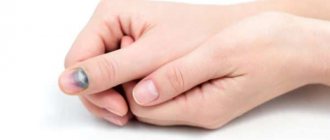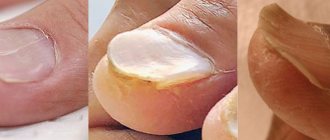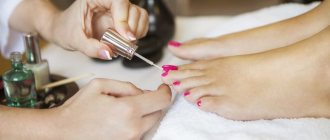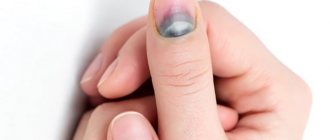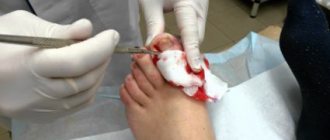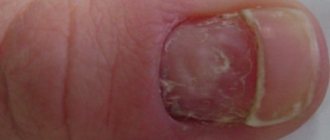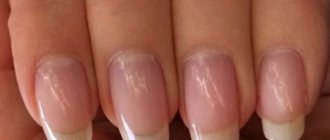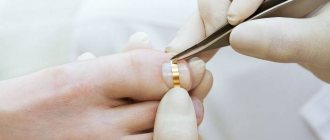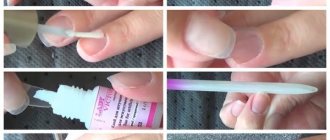When the protective function of the immune system is reduced, the body is most often exposed to microorganisms.
As a result, nail fungus occurs in children, which develops under the negative influence of external or internal factors.
Most children's bodies do not have enough strength to cope with the increased load, so the disease leads to a deterioration in well-being, as well as the manifestation of various complications.
To avoid unforeseen consequences, the mother should be attentive to even minor changes in the condition of the skin and other manifestations characteristic of the fungus. After all, timely detection of pathology will allow for more successful treatment.
How does nail fungus become infected?
Onychomycosis (nail fungus in children) can actively affect the nail plates of the hands and feet.
The spread of the fungus occurs according to a certain pattern, so if you identify traces characteristic of mycosis on the edges of the nails, you should not hope that they will disappear on their own.
On hands
The age of the child has no effect on the proliferation of yeast on the hands . At first, the infection affects the free edges, and then gradually spreads to the bed itself. Then the fungus penetrates deep into the plate and affects the skin around it.
On foot
Nail fungus can occur in children and on the lower extremities (can be seen in numerous photos).
When infected, the first traces of infection can be seen on the nails of the big toes, and after some time, mycosis affects the foot, nail plates and the skin of other fingers.
The inflammatory process begins near the nail folds, as a result of which the cornea becomes thinner and more fragile.
Gradually the plates are covered by transverse waves. And if the focus of the fungus is located under the nail, then, on the contrary, it thickens, after which it actively exfoliates and causes discomfort.
Methods to combat onychomycosis in children
If after diagnosis the diagnosis (nail fungus) is confirmed, treatment is prescribed under the supervision of a doctor. Drugs used to eliminate fungal infections are prescribed according to the age category of the patient.
Treatment of nail fungus in infants and infants is difficult, since systemic therapy can cause more significant harm to the baby’s health than the fungus itself.
Children under two years of age are prescribed gentle antifungal creams and ointments (Bifonazole, Clotrimazole, sulfur-salicylic ointment). They are applied to the affected plates in the morning and evening until the symptoms of the disease completely disappear and a new nail grows.
In children under three years of age, the antifungal agent Griseofulvin is successfully used in the form of a suspension for oral administration, as well as a cream or ointment for rubbing into the nail plates and the skin around them.
Terbizil, Exoderil are used in the form of ointments in children over three years of age. Apply to the affected areas once a day. Treatment takes three weeks or more depending on the extent of the damage.
Effective remedies at the initial stage of the disease are lotions with hydrogen peroxide, frequent application of tea tree oil to the nails, as well as treatment of the nail plates and the skin around them with iodine solution.
For uncomplicated cases in children over 12 years of age, antifungal varnishes and plasters (Batrafen, Lotseril, Mikozan) are used. They penetrate deeply into the stratum corneum of the nail, destroy the structure of the fungus and form a protective coating. Apply varnish 1-2 times a week for 3-6 months. Before use, it is recommended to clean your nails and degrease them with an alcohol solution.
If a fungal infection has spread and there is a potential risk to the baby’s health, systemic treatment (Fluconazole, Intraconazole, Terbinafine) is used. Medicines have strong side effects, so they are used strictly under the supervision of the attending physician in compliance with the prescribed dosage.
To make the process of treating onychomycosis in children faster and more successful, it is necessary:
- thoroughly wash and disinfect the child’s shoes, toys and objects that come into contact with him;
- before using antifungal drugs, it is necessary to steam the nails and carefully remove exfoliated particles;
- change bedding more often;
- treat sick family members and exclude their contact with the child until complete recovery.
An indicator of the success of the treatment is the absence of symptoms, the growth of a healthy nail and negative tests for fungi.
Forms and stages
The development of infection occurs in several stages:
- First stage . Small spots and lines form on the edges or in the center of the plate.
- Second stage . The spots begin to grow rapidly, which is accompanied by peeling of the nail plate.
- Third stage . Dystrophic deformation occurs, in which the nail crumbles, collapses, and the inflammatory process spreads to neighboring tissues.
Experts distinguish several forms of the disease:
- onychorrhexis. Cracks extend from the free edge;
- psoriatic form. The nail changes color, becomes stained, changes thickness;
- onychomadesis. The cause of development is associated with mechanical trauma, as a result of which a purulent mass accumulates under the nail;
- onycholysis. The nail plate gradually peels off from the free edge and eventually peels off completely;
- hapolonychia. Affected nails soften and begin to deteriorate due to fragility;
- Kaylonychia. Dents form on the plates;
- scleronychia. Thickening of the nails and detachment from the bed to the edge occurs. In addition, they acquire a yellowish or brown tint;
- onychogryphosis. The nail thickens and loses its natural shine, becomes rough with an uneven surface;
- trachyonychia. Scales form on the nails;
- onychoschisis. The surface is covered with small transverse grooves;
- anonychia. This form of the disease is rarely acquired; most often it is congenital.
Causes of fungus
Infection can appear as a result of exposure to external and internal factors on the body:
- If a one-year-old or older child runs barefoot around indoors in public places .
- As a result of the baby wearing someone else's clothes and shoes.
- In children around one year of age, their feet sweat and the infection spreads faster.
- As a result of deformation of nails due to mechanical injuries or wearing uncomfortable shoes.
- Contact with other people who are carriers of the fungus;
- Weakened immunity.
Preventive actions
In most cases, disease prevention comes down to following basic hygiene rules:
- check all family members for fungal infections;
- avoid contact with infected people;
- disinfect the bath before bathing the child;
- provide the baby with separate swimwear;
- teach your child not to wear someone else’s shoes;
- increase the child’s immunity using hardening methods;
- feed your baby healthy foods high in vitamins and minerals;
- ventilate and disinfect the living space;
- buy comfortable and high-quality shoes according to the size of the baby’s feet;
- Avoid walking barefoot in public places;
- dry your feet after a bath, especially carefully the area between your toes;
- teach the child to observe hygiene rules;
- have separate tools for treating the child’s nails.
Following these recommendations will help you avoid infection with nail fungus, because the disease is easier to prevent than to undergo long-term treatment.
Symptoms
With nail disease, obvious symptoms that can be noticed by an inexperienced person may appear too late, because the initial stage occurs in a latent form. This will complicate the treatment of onychomycosis, so it is necessary to respond to even minor manifestations of characteristic symptoms:
- modification of the nail plate , in which its condition worsens, is the most common symptom;
- often the infection spreads to the skin of the fingertips, causing it to turn red and begin to swell;
- nails become thinner and become very flaky;
- nail plates crumble even if you don’t press on them;
- nails become white, yellow or gray, and in the last stages of development of the pathology - greenish or black;
- thickening and delamination of nail plates;
- the skin around the nails becomes dry, cracked and itchy.
Attention! The pathogenic microorganism infects the nail completely until it completely destroys the plate. In addition, it spreads to neighboring areas of the skin. Therefore, you should not postpone a visit to the doctor if at least one of the above signs of the disease appears.
Diagnostics
To effectively treat nail fungus in children, it is necessary to accurately determine the form, the reasons for its development, the stage of its progression, as well as the characteristics of the body.
Diagnostics consists of the following activities:
- Studying the child’s medical record to determine characteristics of the body that may predispose to the development of fungus.
- Inspection of the nail plates and nearby skin.
- General blood analysis.
- Blood test for diabetes, AIDS, allergens.
- Analysis of urine.
- Determination of the body's susceptibility to medications.
Prices
| Name of service (price list incomplete) | Price |
| Appointment (examination, consultation) with a pediatric surgeon, primary, therapeutic and diagnostic, outpatient | 1750 rub. |
| Consultation (interpretation) with analyzes from third parties | 2250 rub. |
| Prescription of treatment regimen (for up to 1 month) | 1800 rub. |
| Prescription of treatment regimen (for a period of 1 month) | 2700 rub. |
| Consultation with a candidate of medical sciences | 2500 rub. |
| Hernia repair of umbilical hernia/hernia of the white line of the abdomen, category I. difficulties | 18,000 rub. |
| Removal of condylomas, category I. difficulties | 3550 rub. |
| Removal of condylomas, category II. difficulties | 8900 rub. |
| Excision/removal of benign formations of the skin and mucous membrane, category I. difficulties | 2550 rub. |
Treatment
A baby whose nail plates are affected by fungal microorganisms needs complex treatment.
The doctor must select a therapy that will effectively affect the child’s body, completely destroying all pathogenic microorganisms.
To do this, you can use systemic and local antifungal drugs and folk remedies, as well as immunomodulators, especially if the child is over 3 years old.
Medications
Children's pediatrician Komarovsky advises selecting a treatment regimen taking into account the type of fungus, the stage of the pathology, and the cause of the disease. Treatment must be comprehensive in order not only to completely eliminate the foci of onychomycosis, but also to prevent relapses.
Video consultation about therapy depending on the type of fungus
Dr. Komarovsky explains the principle of treatment for fungal infections on a child’s nails
Experts prescribe:
- topical ointments and creams (Mikozan, Clotrimazole, Lamisil, Exoderil), which contain antifungal substances such as clotrimazole or bifonazole;
- suspensions;
- capsules;
- tablets (“Fluconazole”);
- injections for intramuscular administration;
- special varnishes based on cyclopiroxolamine or amorolfine;
- antifungal patches that kill fungal spores.
Previously, foci of infection were removed surgically. However, more effective drugs are currently used in medicine, so you can only get by with medications .
Important! Therapy is recommended for at least two months to completely destroy yeast spores and prevent the development of onychomycosis in the near future.
Folk recipes
You can try to cure onychomycosis using traditional medicine. However, to obtain the desired therapeutic result, it is necessary to consult with your doctor to exclude the occurrence of side effects.
The most commonly used recipes are:
- If the leg is affected by a yeast fungus, then baths are regularly made from a decoction of milkweed . For infusion, 300 g of herb is poured into a glass of hot water. The decoction should be infused in a steam bath for 30 minutes. Then the liquid is filtered and added to a bowl of warm water. It is necessary to keep the limbs in this liquid for twenty minutes, and then rinse with plain water, dry thoroughly and lubricate with antifungal cream.
- Self-prepared ointment will also help get rid of mycosis. You need to take one chicken egg, beat it and add 1 tbsp. l. vegetable oil. This mixture is applied to the feet before going to bed, wrapping them in polyethylene and putting on woolen socks on top.
- It is recommended to take daily baths with the addition of sea or table salt . This will help quickly eliminate itching of the skin, as well as speed up the regeneration of the affected areas.
Features of treatment in children
If you notice an abscess on your child's finger, be careful. The fact is that not all remedies and treatment methods that are suitable for adults can have a positive effect in children. If the condition worsens, you should immediately contact a specialist.
If a child has ingrown nails into the skin, tamponade is performed. This procedure takes place in several stages. First, your hands are steamed in a warm soda solution. Next, the ingrown toenail is pulled back using a sterile instrument, and a piece of gauze soaked in any antiseptic is placed under the retracted area of the nail plate (we recommend reading: a baby has an ingrown toenail - what to do?). After which the finger is bandaged.
Drug therapy
The choice of treatment method and medications depends on the degree of neglect of the disease and the time that has passed since the onset of felon development. In the early stages, further development of the pathology can be prevented at home using the folk remedies discussed below.
If the child suffers from severe throbbing pain and the swelling does not subside, you should seek help from a surgeon. The specialist will examine the baby, make a diagnosis and prescribe treatment. Abscesses are treated using the following means:
- Levomekol is an antibiotic-based ointment. It draws out pus well. After disinfection, apply to the inflamed area.
- Ichthyol ointment. It is applied to the pathological area. It has the ability to penetrate deep into the skin, where it kills pathogenic bacteria, soothes and reduces inflammatory processes, relieving swelling and reducing pain.
- Antifungal ointments. Used when the fungus penetrates the affected tissues. The following drugs are suitable for children: Mikozan, Batrafen, Demikten, Belvedere. Before applying the product to the nail, the damaged areas are filed off with a nail file.
READ ALSO: Rash on a child’s body; photo with explanations: small, goosebump-like, red and without itching
Folk remedies
Folk remedies are best used in the early stages of the disease, as they will not help cure complications. Such drugs are loyal to the immune system and usually do not cause side effects.
For a small cut, improvised means such as ice or any item in the freezer will help. Using it, a cold compress is applied to the problem area. Cold slows down metabolism, thereby stopping the inflammatory process. This compress will also reduce pain and swelling.
Other effective folk remedies include:
- Baths with furatsilin solution. Place the baby's sore finger in the bath for 10-15 minutes, then rinse and bandage with a loose, not very tight bandage.
- Applications with blue clay, which has the property of drawing pus from the wound, while simultaneously disinfecting the affected area. It also has a bactericidal effect, so it can be applied to an open wound. The clay is applied to a bandage, which is applied to the disturbing area. This compress should be kept for 3-4 hours, after which the area of skin that was under the bandage is washed and sealed with a sterile bandage.
READ ALSO: Spots on the back: photos, possible diseases, symptoms | Skin diseases
In what cases is surgery required?
What to do if the patient does not recover, and the damaged area festers even more? A surgeon comes to the rescue. He examines the small patient and then operates on the problem area. The pus is cut out from the wound, then it is washed with an antiseptic solution. After the operation, the finger is bandaged, the sterile bandage is changed 3-4 times a day.
Prevention
Treatment of onychomycosis is a rather complex process, so it is easier to pay attention to preventive measures to reduce the risk of infection with Candida fungus. Doctors advise following a few simple rules:
- if children visit the pool or other public places, the parent must explain to them that they must use only personal belongings ;
- children and teenagers should not walk down the street without shoes;
- try to avoid injuries to the feet, palms and, in fact, nails;
- it is necessary to monitor the child’s health and, after suffering from illness, to increase the protective functions of the immune system;
- give preference to comfortable shoes made from natural materials;
- buy good quality socks and tights for children;
- The disease can be prevented with the help of special baths made from a decoction of herbs, which has an antiseptic, antimicrobial, and antifungal effect;
- Infection can be prevented by promptly contacting a dermatologist in case of any changes in the condition of the nail plates and skin.
An adult is responsible for the health of children . And in order to prevent the consequences of onychomycosis, it is necessary to pay attention to the child’s complaints of discomfort and pain in the area of the nails of the feet and hands. This will reduce the risk of developing pathology or quickly get rid of the manifestations of an already existing fungus with the help of medications, as well as folk remedies.
